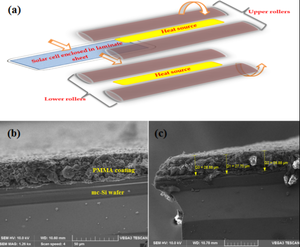
The impact of encapsulation on solar photovoltaic (PV) modules includes insulation and protection, which alters the device performance as a function of wavelength of incoming light. Most lab-scale PV research ignores these features, but with a promising rise in front surface spectral conversion mechanisms, methods of optical enhancement and biomimetic layers makes this oversight unacceptable. To enable encapsulation of lab-scale PV, this study evaluates a simple encapsulation method. Multi-crystalline silicon (mc-Si) wafers were encapsulated using a pouch laminator and compared with a (poly)-methyl methacrylate (PMMA) front coated cell and an unencapsulated control cell. The cell’s diffuse reflectance with the encapsulant exhibits better photon absorption in UV region, which is verified from improved external quantum efficiency. Despite the loss of a small percentage of visible photons, the electrical performances of the encapsulated cells were not affected. On the other hand, the PMMA coated cells showed an outstanding photon to electron conversion, but did not result in effective charge collection. The results show that a low-cost pouch laminate at the lab scale is an adequate method for encapsulating solar cells without overly degrading performance. In addition, for short lifetime small-scale PV applications, this method represents a means of distributed PV manufacturing.
Highlights[edit | edit source]
- Demonstrating a labs-scale prototype pouch lamination for solar cell encapsulation.
- Focus is on technical viability of the encapsulant for realistic testing within lab.
- Encapsulated mc-Si cells are compared with PMMA front coated & unencapsulated cells.
- Encapsulated device’s DRS exhibit photon absorption in UV which is verified by EQE.
- The PMMA coated cells showed an outstanding photon to electron conversion.
Keywords[edit | edit source]
encapsulant, PMMA, lamination, silicon solar cells, surface coating, Photovoltaic
See also[edit | edit source]
- MACE nano-texture process applicable for both single- and multi-crystalline diamond-wire sawn Si solar cells
- Influence of metal assisted chemical etching time period on mesoporous structure in as-cut upgraded metallurgical grade silicon for solar cell application
- Economic Advantages of Dry-Etched Black Silicon in Passivated Emitter Rear Cell (PERC) Photovoltaic Manufacturing
- Effects of silver catalyst concentration in metal assisted chemical etching of silicon
- Advances in plasmonic light trapping in thin-film solar photovoltaic devices
- Plasmonic Perfect Meta-Absobers for a-Si PV Devices
- Multi-resonant silver nano-disk patterned thin film hydrogenated amorphous silicon solar cells for Staebler-Wronski effect compensation
- A new method of preparing highly conductive ultra-thin indium tin oxide for plasmonic-enhanced thin film solar photovoltaic devices
- Ambiance-dependent Agglomeration and Surface-enhanced Raman Spectroscopy Response of Self-assembled Silver Nano-particles for Plasmonic Photovoltaic Devices





